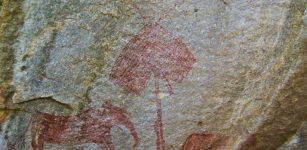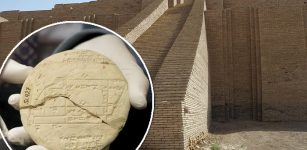Did The Ancient Trojan Horse Really Exist?
Ellen Lloyd - AncientPages.com - Our ancient human history is full of terrible wars. This is one of many wars that will never be forgotten. More than 3,000 years ago a horrible war broke out between the ancient Greeks and the Trojans. It lasted for 10 years and neither side seemed to be able to win this war.
The Greeks gathered the greatest army in the world and one thousand ships sailed to take the great city of Troy. For ten years, the best warriors waged fierce battle but in vain. Troy's massive walls still stood protecting its citizens.
 The Mykonos vase, with one of the earliest known renditions of the Trojan Horse. (Note the depiction of the faces of hidden warriors shown on the horse's side.) Image credit: Travelling Runes - CC BY-SA 2.0
The Mykonos vase, with one of the earliest known renditions of the Trojan Horse. (Note the depiction of the faces of hidden warriors shown on the horse's side.) Image credit: Travelling Runes - CC BY-SA 2.0
One day, Odysseus, the ruler of the island of Ithaca got a brilliant idea. He ordered to build a big wooden horse on wheels, big enough to hide a bunch of Greek soldiers inside it.
The wooden horse was built. Acting like they had given up their long fight, most of the Greeks pretended to sail home. Only one small group of soldiers stayed, hiding inside the horse. The Trojans found the wooden horse but did not understand its presence.
Soon they also found a Greek soldier hiding nearby. He explained that his companions hated him and therefore they had left him behind. When asked about the sudden presence of the strange wooden horse in the vicinity of the city, the Greek soldier said that it was an offering to the patron goddess, Athena.
No one in the city of Troy wanted to offend the goddess Athena, so they decided to drag the large horse into the city.
None of Troy's gates was big enough to get it in, so they had to tear down a piece of the city wall to get the wooden statue inside.
 Some of the ruins of ancient Troy were discovered in present-day Turkey. Image credit: National Chiao Tung University.
Some of the ruins of ancient Troy were discovered in present-day Turkey. Image credit: National Chiao Tung University.
They left it at the temple of Athena and prepared a big party to celebrate their victory and the final end of a long war. In the meantime, the Greek soldiers were still sitting quietly inside the horse statue.
This was the last party in the Trojan lives. They allowed themselves to be totally fooled by the Greeks' trick. It cost much.
At night, when the citizens of Troy had fallen asleep, the Greek soldiers came out of the Trojan Horse and killed the guards on the walls. They opened the gates of Troy and gave the signal to the Greek hiding nearby to storm the city. There was a big battle and the city was totally destroyed. The Trojans could not win this war; the Greeks did.
Is there any truth behind the myth of the Trojan horse?
The Trojan Horse is mentioned in the great poem "Aeneid" written by a classical Roman poet, Virgil, in 19 BC and in other ancient Greek sources. The event is referred to in Homer's Odyssey. In the Greek tradition, the horse is called the "Wooden Horse".
Pausanias, a Greek traveler, and geographer of the 2nd century AD theorized that the Trojan horse was a gigantic battering ram whose form reminded of a horse.
The Procession of the Trojan Horse in Troy by Giovanni Domenico Tiepolo (1727–1804). Credit: Public Domain
Ancient Greek historians believed that the siege of Troy was probably between 1300 and 1100 BC, and it is known that the Assyrians at this time had the habit of naming their great siege machines after animals.
There has been speculation that the Trojan Horse may have been a battering ram slightly resembling a horse. The description of the use of this device was then transformed into a myth by later oral historians who were not present at the battle and were unaware of the meaning of the name. In those days it was common for Assyrians to use siege machines with animal names, often covered with dampened horse hides to protect against flaming arrows.
The Trojan Horse could have been one of such siege machines built by the Greeks in order to finalize their warplanes.
Written by - Ellen Lloyd – AncientPages.com
Copyright © AncientPages.com All rights reserved. This material may not be published, broadcast, rewritten or redistributed in whole or part without the express written permission of AncientPages.com
More From Ancient Pages
-
 Yenikapı Excavations Reveal 8,500-Year-Old Artifacts
Archaeology | Jan 10, 2016
Yenikapı Excavations Reveal 8,500-Year-Old Artifacts
Archaeology | Jan 10, 2016 -
 The Caesar Cipher: Ancient And Simple Yet Effective Cipher Used By Julius Caesar
Ancient History Facts | May 30, 2018
The Caesar Cipher: Ancient And Simple Yet Effective Cipher Used By Julius Caesar
Ancient History Facts | May 30, 2018 -
 On This Day In History: Greek Archaeologist Manolis Andronikos Who Discovered Tomb of Philip II of Macedon, Was Born – On Oct 23, 1919
News | Oct 23, 2016
On This Day In History: Greek Archaeologist Manolis Andronikos Who Discovered Tomb of Philip II of Macedon, Was Born – On Oct 23, 1919
News | Oct 23, 2016 -
 Archaeologists Encounter A 1,500-Year-Old Mystery In Kent, UK
Archaeology | Mar 16, 2022
Archaeologists Encounter A 1,500-Year-Old Mystery In Kent, UK
Archaeology | Mar 16, 2022 -
 Humans Got To America 7,000 Years Earlier Than Thought – New Research Confirms
Archaeology | Oct 9, 2023
Humans Got To America 7,000 Years Earlier Than Thought – New Research Confirms
Archaeology | Oct 9, 2023 -
 Suprising Discovery Of A Well-Preserved Ancient Roman Road In London, UK
Archaeology | Nov 19, 2024
Suprising Discovery Of A Well-Preserved Ancient Roman Road In London, UK
Archaeology | Nov 19, 2024 -
 Picts: Facts And History About Mysterious People Of Northern Scotland
Civilizations | Feb 2, 2016
Picts: Facts And History About Mysterious People Of Northern Scotland
Civilizations | Feb 2, 2016 -
 Library Of Celsus: Beautiful Classic Monument In Ephesus That Stored 12,000 Scrolls
Civilizations | Nov 14, 2018
Library Of Celsus: Beautiful Classic Monument In Ephesus That Stored 12,000 Scrolls
Civilizations | Nov 14, 2018 -
 On This Day In History: Edict Of Pistres ‘A New Law’ Against Viking Raids Issued – On July 25, 864
News | Jul 25, 2016
On This Day In History: Edict Of Pistres ‘A New Law’ Against Viking Raids Issued – On July 25, 864
News | Jul 25, 2016 -
 Mystery Of Ancient Roman Concrete That Still Stands Strong – Has A 2,000-Year-Old Engineering Puzzle Been Solved?
Ancient Technology | Jul 5, 2017
Mystery Of Ancient Roman Concrete That Still Stands Strong – Has A 2,000-Year-Old Engineering Puzzle Been Solved?
Ancient Technology | Jul 5, 2017 -
 Unearthing The Mystery Of The Meaning Of Easter Island’s Moai
Archaeology | Dec 15, 2019
Unearthing The Mystery Of The Meaning Of Easter Island’s Moai
Archaeology | Dec 15, 2019 -
 On This Day In History: Spanish Conquistadors Led By Hernan Cortés Entered The Aztecs Capital Tenochtitlán – On Nov 8, 1519
News | Nov 8, 2016
On This Day In History: Spanish Conquistadors Led By Hernan Cortés Entered The Aztecs Capital Tenochtitlán – On Nov 8, 1519
News | Nov 8, 2016 -
 Mysterious ‘Temple Of The Crossed Hands’ Of Kotosh – One Of The Oldest Structures In Peru
Featured Stories | Mar 15, 2023
Mysterious ‘Temple Of The Crossed Hands’ Of Kotosh – One Of The Oldest Structures In Peru
Featured Stories | Mar 15, 2023 -
 Translated Ancient Text Offers Evidence Of An Unknown Sophisticated Civilization Present In All Corners Of The World
Civilizations | Sep 18, 2022
Translated Ancient Text Offers Evidence Of An Unknown Sophisticated Civilization Present In All Corners Of The World
Civilizations | Sep 18, 2022 -
 Largest In Europe Underground Church Of Saint-Jean of Aubeterre Built By 12th Century Benedictine Monks
Featured Stories | Feb 12, 2016
Largest In Europe Underground Church Of Saint-Jean of Aubeterre Built By 12th Century Benedictine Monks
Featured Stories | Feb 12, 2016 -
 10 Remarkable Advanced Ancient Technologies Ahead Of Their Times
Ancient Technology | Jul 23, 2019
10 Remarkable Advanced Ancient Technologies Ahead Of Their Times
Ancient Technology | Jul 23, 2019 -
 2,000-Year-Old Stela And ‘Laboratory’ Of Early Maya Writing Found In Guatemala
Archaeology | Mar 15, 2020
2,000-Year-Old Stela And ‘Laboratory’ Of Early Maya Writing Found In Guatemala
Archaeology | Mar 15, 2020 -
 “Hittite Forest” That Grew 4,500 Years Ago Will Be Created In Alacahöyük, Turkey
Archaeology | Dec 21, 2015
“Hittite Forest” That Grew 4,500 Years Ago Will Be Created In Alacahöyük, Turkey
Archaeology | Dec 21, 2015 -
 Hundreds Of Rock Paintings Found In Tanzania By Polish Archaeologist
Archaeology | Jul 11, 2018
Hundreds Of Rock Paintings Found In Tanzania By Polish Archaeologist
Archaeology | Jul 11, 2018 -
 Discovered 3,700-Year-Old Clay Tablet Shows Babylonians Used Geometry Long Before Pythagoras
Archaeology | Aug 4, 2021
Discovered 3,700-Year-Old Clay Tablet Shows Babylonians Used Geometry Long Before Pythagoras
Archaeology | Aug 4, 2021

